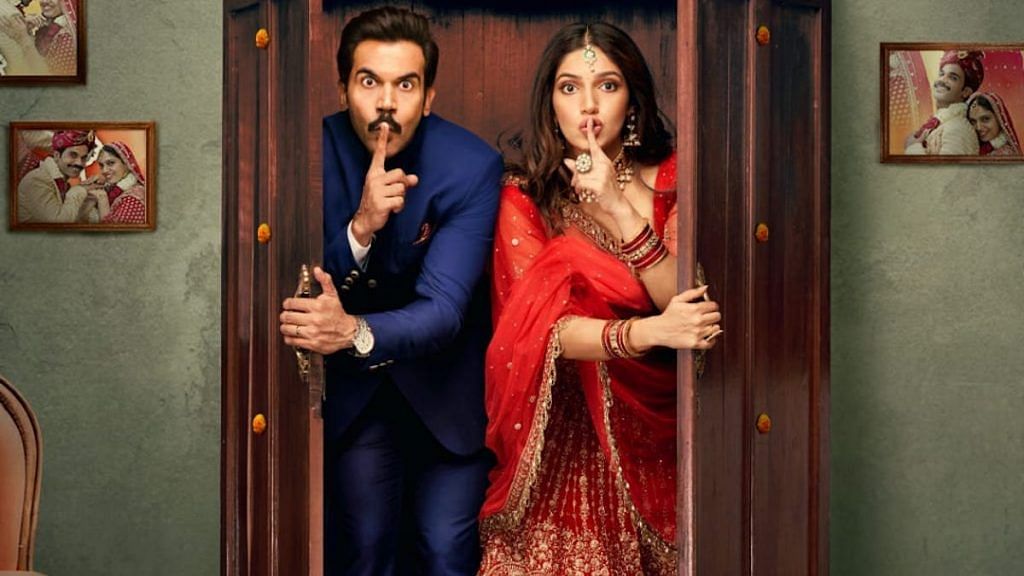In yet another edition of popularising India’s LGBT+ community, Bollywood is screening a new movie soon — ‘Badhaai Do’ starring Bhumi Pednekar and Rajkummar Rao.
The recently released trailer shows a lesbian woman marrying a gay guy in small-town India. This concept of opposite sex homosexuals marrying each other is called a ‘lavender marriage’.
The film, which boasts of a ‘Satrangi setting’, has Rajkummar Rao playing a gay policeman who wants to marry Bhumi Pednekar, a lesbian PT teacher, to get their families off their backs. It releases on 11 February.
While the trailer looks promising and is garnering rave reviews, there’s a problem — popularising lavender marriages can set the LGBT+ community in India a few steps back again. And can hinder the fight for same-sex marriages.
Also read: In Chandigarh Kare Aashiqui, Ayushmann Khurrana confronts transphobia, and well
A little too late
I am glad that over the last couple of years, the Hindi cinema industry has brought conversation around homosexuality to the table. So many of my gay friends, who came out recently, now sit down with their families and have something Indian to showcase that their sexuality is completely fine. After all, films play a large part in Indian psyche and thought.
Chandigarh Kare Ashiqui (2021), Shubh Mangal Zyada Saavdhan (2020), and Ek Ladki Ko Dekha Toh Aisa Laga (2019) have been watched by many and streamed on mainstream channels and OTT platforms. That’s a good thing. However, showing a lavender marriage feels a bit dated now in a post-377 India.
During the times when homosexuality meant death or life imprisonment — especially during the early 20th century — a lot of gay celebrities went through such marriages of convenience that would keep their public image ‘straight’. The most famous one is Rock Hudson — who lived as a Hollywood star and a closeted gay man — and was also one of the first major celebrities who died of AIDS in 1985. It is said that Hudson married his secretary Phyllis Gates, in order to prevent backlash against the homosexual community, which Hollywood was known for.
Fast forward to the second decade of the 21st century — with so much activism, vocal support for the LGBT+ community, Section 377 struck down and the loss of fear of being judged (at least in tier-1 and tier-2 cities) — coming out as gay is a bit easier, even though it still carries stigma.
The Delhi High Court is hearing pleas on same-sex marriages and the matter is listed for 3 February this year. If the final verdict is in favour of the LGBT+ community, India will no longer be a red dot on the global map of equal marital rights for all.
Nonetheless, with LGBT+ activism touching everyone, there is no incentive for gay men to marry lesbian women now — unless forced by a family against their will. In fact, many gay men that I know are actually denying sexual favours or relationships with married men. They don’t want to be ‘marriage wreckers’, they say.
So, mainstreaming lavender marriage now is just too late. Had the film been made before the Delhi High Court decriminalised homosexuality in 2009 (which was later recriminalised by the Supreme Court in 2013 and again decriminalised in 2018), it would have made more sense.
Also read: Men on ‘marriage strike’ against marital rape laws. Some people laugh, say good riddance
What I fear
The only fear that I have is that Badhaai Do might popularise this outdated culture of lavender marriages — unintentionally. There will be many gays and lesbians and Indians with other sexual orientations who will watch this movie and get the idea to find an opposite-sex LGBT+ partner to keep society’s prying eyes away.
Despite all these pride parades, LGBT+ movies and awareness, Indian society is still extremely patriarchal especially when it comes to marriage — not an outlier from its South Asian counterparts.
A BBC report in 2017 revealed how Muslim gay men from South Asia were having these marriages of convenience in England — where same-sex marriages were legalised in 2014 — simply because they didn’t want to get expelled from the community they grew up in.
Even in India, there are ‘family loving’ gays, who have been marrying women, not for themselves but just to keep their families happy, even if it gives them lifelong suffering.
And to be honest, if marriage is an institution of love and physical intimacy, and not just raising kids, then what is the meaning of two people not made to love each other living together and sleeping with somebody else?
My conversation with a lesbian friend at a gay party was quite revealing. She told me about a gay man’s family willing to pay her for a ‘heterosexual marriage’ with their son. She also told me that patriarchy later kicks in such marriages, where the woman has to eventually face the brunt of the man’s family, abusive in-laws and toxic masculinity from her husband. And there is always the expectation that having a child will ‘fix’ everything.
Lavender marriages are recipes for disasters. And divorce is the only happy ending I am willing to see in Badhaai Do.
Views are personal.
